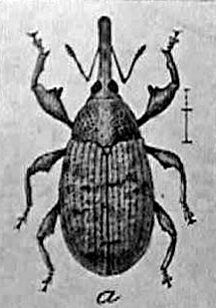The Great Depression cast its economic shadow across major economies in the western world, and while northern states in the United States were predominantly oriented toward manufacturing and engineering, the State of Georgia maintained its focus on an agrarian economy. This regional emphasis, however, confronted a significant challenge during the era in the form of the invasive species known as the Boll Weevil.
This diminutive insect posed a threat to the agrarian landscape, particularly in the South, where cotton was a primary economic crop. The Boll Weevil, upon encountering cotton crops, would lay eggs within the cotton bolls. Once hatched, the young weevils consumed the cotton both as a food source and as a means to escape the boll. This insidious behavior proved devastating for southern farmers, swiftly leading to the destruction of their cash crops over a relatively brief period.
Compounding the economic distress, the State of Georgia grappled with a severe drought in 1925, further exacerbating the challenging conditions of the time. The convergence of the Boll Weevil infestation and the drought underscored the vulnerability of the agrarian economy, leaving a lasting impact on the economic landscape of the state during this tumultuous period.
Georgia Encyclopedia author Jamil S. Zainaldin writes:
Between 1918 and 1928 the price of cotton decreased from 28.88 cents/pound to 17.98 cents/pound, and then bottomed out in 1931 at 5.66 cents/pound. To keep up with the lower prices being offered for their products, farmers needed to purchase expensive new farm machinery, but only a few rich landowners had the money to afford such investments.[1]
The impact of the Great Depression was particularly pronounced in Henry County, where the predominant focus on cotton farming bore the brunt of economic challenges. In 1930, the county witnessed a significant 22% decrease in its population, resulting in a diminished workforce.[2] Historical records suggest that a substantial portion of those who departed were African-Americans participating in the Great Migration—a period characterized by the migration of many African-Americans from the South to seek enhanced job opportunities in the North.
While sharecroppers and farmers grappled with hardships, the local cities, including McDonough, seemed to maintain a semblance of normalcy. In a move, the city council sought a referendum to pave the roads throughout McDonough. The outcome reflected a positive response from the community, with 307 individuals voting "Yes" and a mere 7 voting "No."[3] This civic engagement in infrastructure development hinted at a resilient spirit within the local population.
However, not everyone in the county emerged unscathed from the challenges of the Depression. The Locust Grove Institute, for instance, faced adversity and had to close its doors as patronage declined. Some researchers speculate that the expansion of public schools throughout the county might have contributed to this decline.
Despite localized hardships, the county, as a whole, did not undergo substantial transformations during the Depression. The problems were somewhat contained, and the major brunt was felt by sharecroppers who were already grappling with precarious financial situations. As the Depression hit, many sharecroppers opted to migrate north in search of more viable employment opportunities, leaving behind their homes in pursuit of economic stability.
[1]: Zainaldin, Jamil. "Great Depression." New Georgia Encyclopedia, last modified Sep 29, 2020. https://www.georgiaencyclopedia.org/articles/history-archaeology/great-depression/
[2]: "Population of Counties by Decennial Census: 1900 to 1990". United States Census Bureau. [3]: https://copolkmuseum.org/mcdonough-history/





Comments